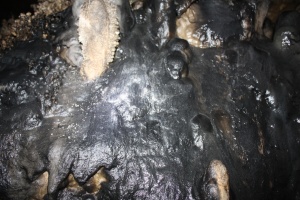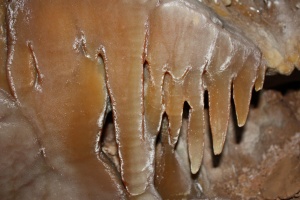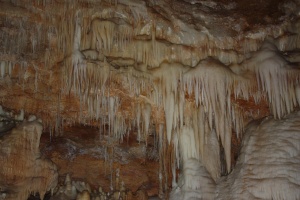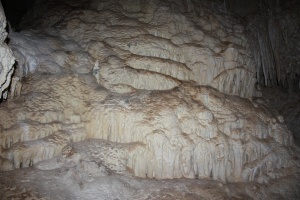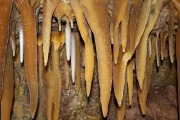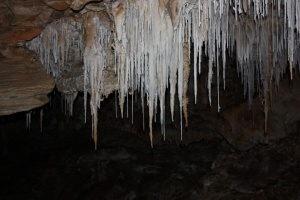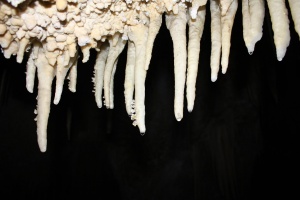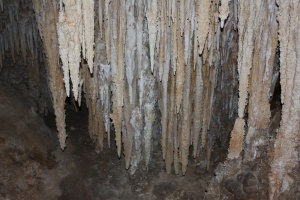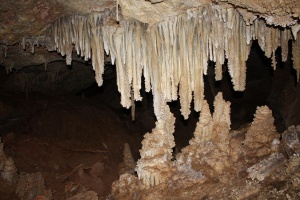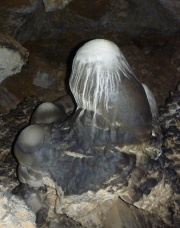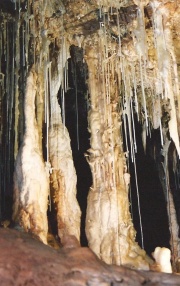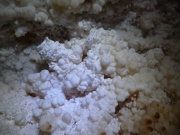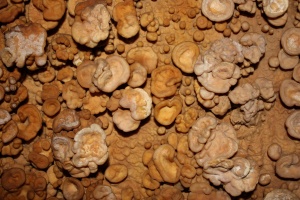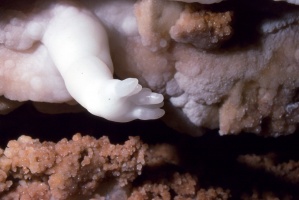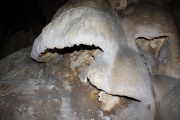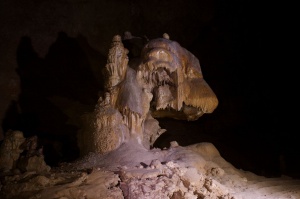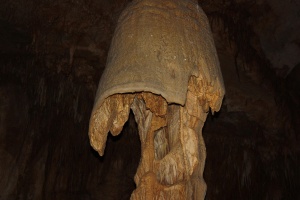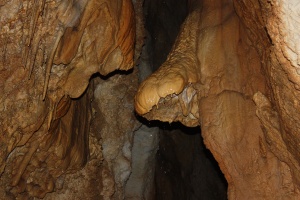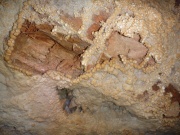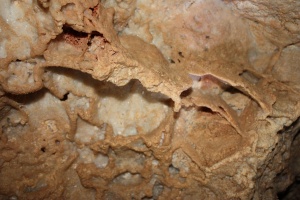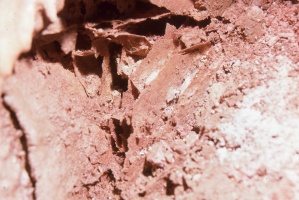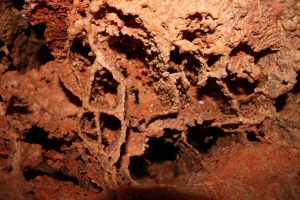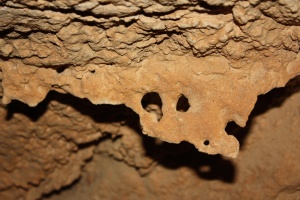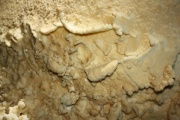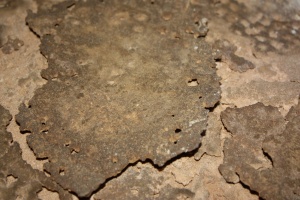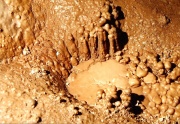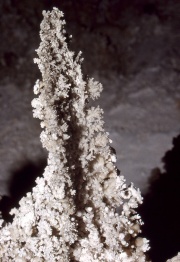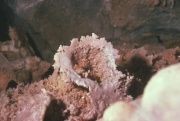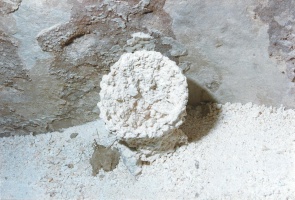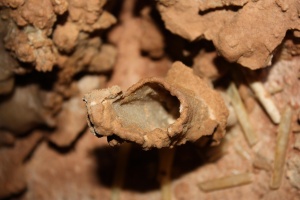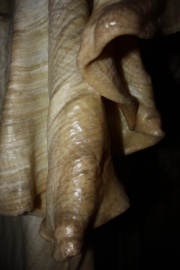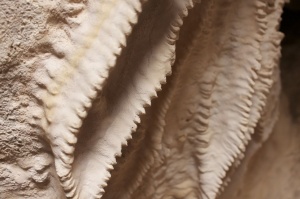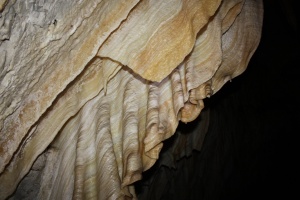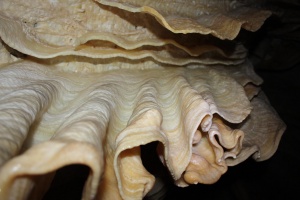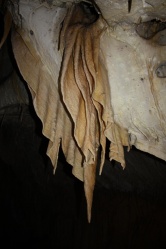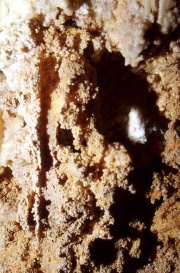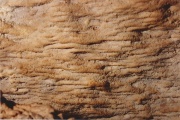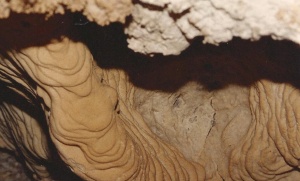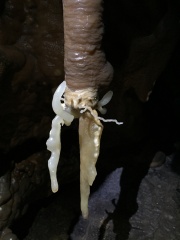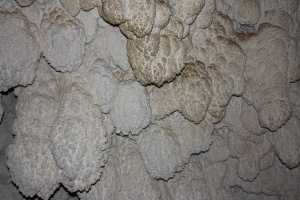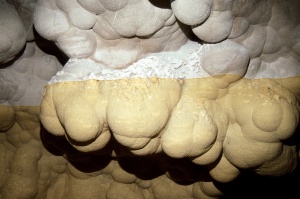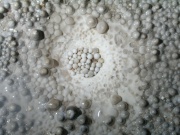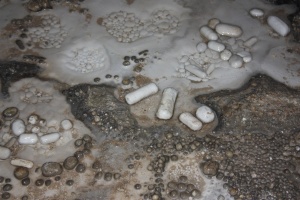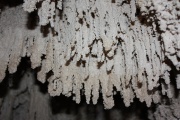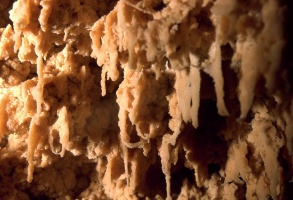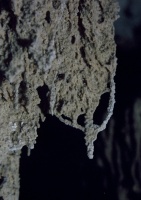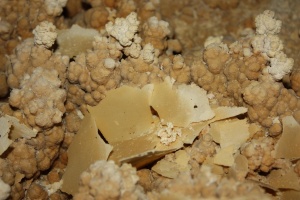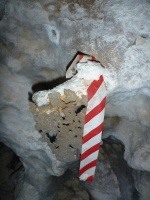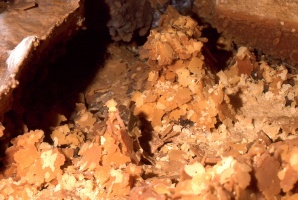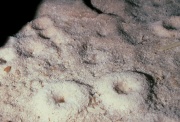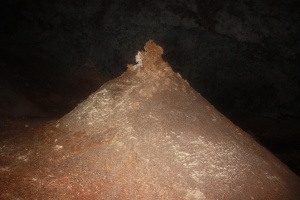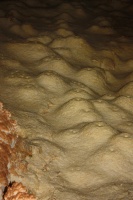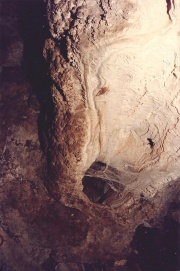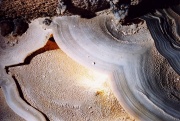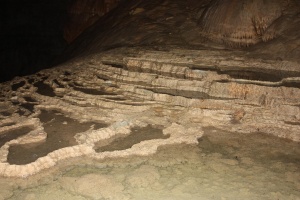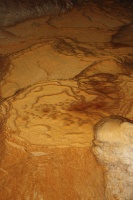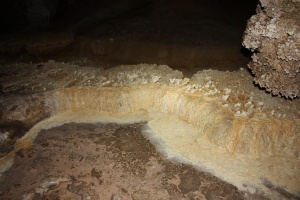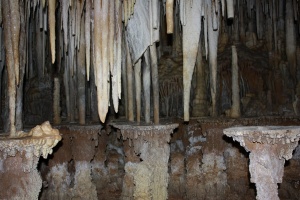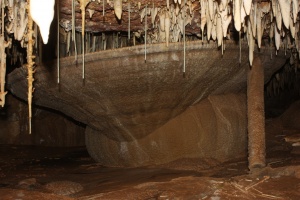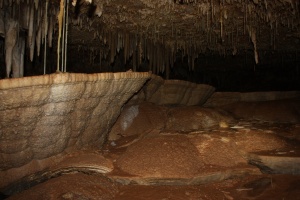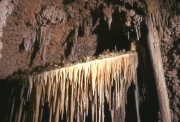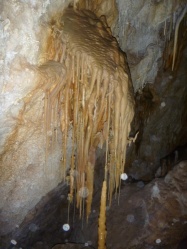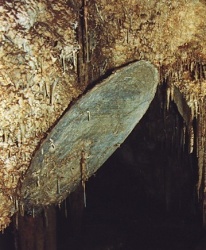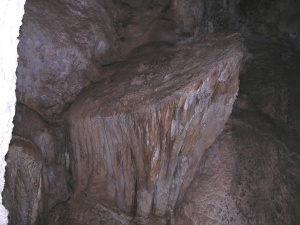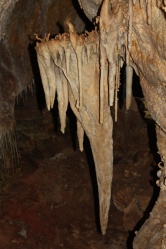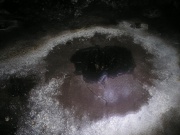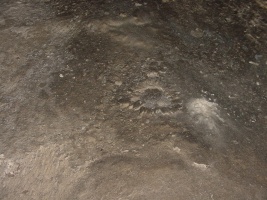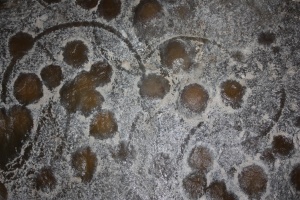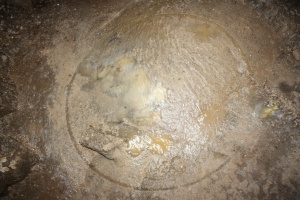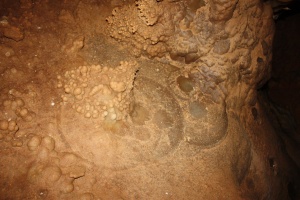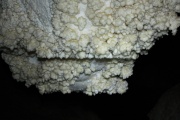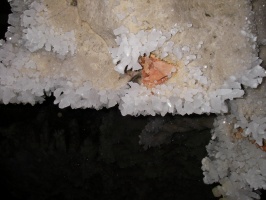Calcite (Inventory)
From LagWiki
Flowstone
The Flowstone field of the Calcite section should record any observation of flowstone that is not some other more specific speleothem.
Flowstone is one of the most common of speleothem types and exhibits as cascading sheets of calcite flowing over obstructions like a frozen waterfall. It is deposited when water flows in thin films.
Flowstone can vary in both size and color. The color varieties can be great and can be in complex, multicolored combinations. Color combinations can include: white, cream, yellow, orange, red, carmel and even black. Flowstone can exhibit a velvetine texture or be very smooth. It may be dry or moist. It may exhibit on the walls, cascading out of high leads or on the floor. Often other speleothem types exhibit where flowstone is found.
See also
References
- Hill, Carol; Paolo Forti (1997) Cave Minerals of the World (Second Edition ed.) National Speleological Society pp 70-72 ISBN: 1-879961-07-5
- Palmer, Arthur N. (2007) Cave Geology CAVE BOOKS, Dayton, OH pp 280-281 ISBN-13: 978-0-939748-66-2, ISBN-10: 0-939748-66-5
Flowstone, Calcite
Stalactite
The Stalactite field of the Calcite section should list stations where stalactites are observed.
Stalactites are ceiling formations that hang downward like icicles. Stalactites may appear individually or in groups, sometimes tremendous groups, with other speleothem types associated such as stalagmites and draperies. They may be any of a number of colors and can vary in size from tiny to massive.
When a stalactite joins with a stalagmite or reaches the floor, a column is formed.
Two specific subtypes of stalactite have their own fields on the form. These are deflected stalactites and soda straws. These subtypes should be recorded in the respective subfields. Only calcite stalactites that are not deflected and are not straws should be recorded in this field.
Look for stalactites on the ceiling and overhanging ledges.
See also
References
- Palmer, Arthur N. (2007) Cave Geology CAVE BOOKS, Dayton, OH pp 281-282 ISBN-13: 978-0-939748-66-2, ISBN-10: 0-939748-66-5
- Hill, Carol; Paolo Forti (1997) Cave Minerals of the World (Second Edition ed.) National Speleological Society pp 104-108 ISBN: 1-879961-07-5
Fields
Stalactite, Calcite
Stalagmite
The Stalagmite field of the Calcite section should list stations where calcite stalagmites are observed. Gypsum stalagmites and aragonite stalagmites have their own fields on the form.
Stalagmites are secondary floor deposits usually of calcite. They are one of the most commonly encountered formations and exhibit as pillars built up by water dripping from the ceiling. The drip source often exhibits a stalactite but not always. Stalagmites are usually larger in diameter than any corresponding stalactite with rounded tops instead of pointed. Stalagmites can vary greatly in size and shape from small to massive formations; from tall, thin poles to wide, fat mounds and anything in between. Stalagmites can be smooth; popcorn covered; layered like piles of plates; fluted; or covered with various other deposits including bell canopies. A stalagmite which has joined with its corresponding stalactite is known as a column.
A calcite stalagmite of any size or shape should be recorded in this field.
See also
References
- Hill, Carol; Paolo Forti (1997) Cave Minerals of the World (Second Edition ed.) National Speleological Society pp 108-112 ISBN: 1-879961-07-5
Column
The Column field of the Calcite section should record any stations that exhibit columns.
Columns form when a stalactite joins a stalagmite making a continuous formation from ceiling to floor.
Columns can vary greatly in both thickness and height. Columns can be massive floor to ceiling formations with great thickness or smaller formations that reach from ceiling to floor in an alcove. A column could be as simple as a single soda straw which has managed to reach the floor; but, these would normally be inventoried as straws and not columns. However, if a straw is the connection between two more substantial formations, a column is the more appropriate inventory category.
See also
References
- Hill, Carol; Paolo Forti (1997) Cave Minerals of the World (Second Edition ed.) National Speleological Society pp 56-57 ISBN: 1-879961-07-5
- Palmer, Arthur N. (2007) Cave Geology CAVE BOOKS, Dayton, OH p 283 ISBN-13: 978-0-939748-66-2, ISBN-10: 0-939748-66-5
Popcorn
The Popcorn field of the Calcite section should be used to record stations where cave popcorn is found.
Cave popcorn are small balls of calcite, aragonite and more rarely gypsum which project from surfaces such as bedrock and other speleothems. They usually appear in clusters but can rarely occur singularly. Dense growths of popcorn that terminate downwardly are known as trays. Popcorn can form almost anywhere and comes in a few varieties including button popcorn which has flattened nodules. Any observation of popcorn no matter its composition should be recorded here. Popcorn nodules may be smooth like flowstone or chalky and round like edible popcorn. They may be decorated with frostwork and may appear only on one side of speleothems, usually the windward side. The clusters may terminate abruptly in a stratographic layer in either an upward or downward direction. The size of each individual nodule can vary from tiny to small but usually does not grow much bigger than an inch or so. The color is usually white but various other colors are possible, too.
See also
References
- Palmer, Arthur N. (2007) Cave Geology CAVE BOOKS, Dayton, OH p 288 ISBN-13: 978-0-939748-66-2, ISBN-10: 0-939748-66-5
- Hill, Carol; Paolo Forti (1997) Cave Minerals of the World (Second Edition ed.) National Speleological Society pp 59-61 ISBN: 1-879961-07-5
Popcorn, Calcite
Bell Canopy
The Bell Canopy field of the Calcite section should list stations that exhibit a bell canopy.
Bell canopies are sheets of flowstone that flare outward as they descend. They terminate before reaching the floor so as to form hood or bell shapes. Bell canopies can form hoods over older formations or be suspended from the ceiling, walls or other speleothems. They form by weathered material that flows as a paste and hardens, or by water that evaporates before dripping off of the edge.
References
- Palmer, Arthur N. (2007) Cave Geology CAVE BOOKS, Dayton, OH pp 283-284 ISBN-13: 978-0-939748-66-2, ISBN-10: 0-939748-66-5
Bell Canopy, Calcite
Boxwork
The Boxwork Calcite inventory field should be used to list stations which exhibit boxwork.
Boxwork is not technically a speleothem but a speleogen. That is, it is not a formation but a residual of dissolution. Boxwork forms when cracks in the bedrock are filled with a mineral which is harder to dissolve than the bedrock itself. When the bedrock dissolves, it leaves the mineral which used to fill the cracks exposed. It often appears on the ceiling but may be present anywhere bedrock is exposed. It may be obscured by secondary formations. Boxwork can appear as small examples or large areas. It often takes on polygonal shapes (usually rectangular) but may be almost any shape. It need not project far from the rock to be considered boxwork. Often it is a different color than the bedrock (usually darker). Alternative explanations for boxwork exist which involve cracks in the bedrock being filled with minerals after the cave formed.
Although the field appears in the calcite section of the CCNP Cave Inventory Form, any boxwork no matter its specific mineral content (which may be difficult to identify anyway and may not be calcite) should be listed.
References
- Palmer, Arthur N. (2007) Cave Geology CAVE BOOKS, Dayton, OH pp 343-344 ISBN-13: 978-0-939748-66-2, ISBN-10: 0-939748-66-5
- Hill, Carol; Paolo Forti (1997) Cave Minerals of the World (Second Edition ed.) National Speleological Society pp 52-54 ISBN: 1-879961-07-5
Boxwork, Calcite
Boxwork with a calcite coating |
Calcite Coating
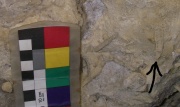
The Calcite Coating inventory field should be used to list stations where a coating of calcite is found.
A calcite coating is a thin layer or layers of calcite usually over bedrock or breakdown. It is much thinner than a calcite crust and more tightly adhered to the underlying structure.
It is sometimes difficult to differentiate between a calcite coating, an aragonite coating, a gypsum coating, and even moonmilk. The distinctions between a calcite coating and a calcite crust may also be subtle.
Calcite tends to have square-ish crystals. Gypsum sometimes makes starbursts. Aragonite and moonmilk are both bright white. Aragonite coatings are not an inventory item on the CCNP Cave Inventory Form and should be inventoried as a calcite coating, so there is no need to distinguish between these two. Calcite coatings can have a wide variety of colors. Calcite coatings can also be entirely clear. Coatings may build up in layers, coating upon coating, to form thicker coatings.
Sometimes it is difficult to positively differentiate between different coatings in the field without destructive testing.
See also
References
- Hill, Carol; Paolo Forti (1997) Cave Minerals of the World (Second Edition ed.) National Speleological Society pp 55-56, 145 ISBN: 1-879961-07-5
Calcite Crust
The Calcite Crust inventory field should be used to list stations where a crust of calcite is found.
A calcite crust is a layer of calcite that is thicker and less firmly adhered to the substructure than a calcite coating. Calcite crusts can form over almost any other material. They can be thin or thick. Often, they are fragile and easily broken, especially on floor sediments, if stepped on or touched so great care should be taken not to damage them.
The distinctions between a calcite coating and a calcite crust may be subtle.
See also
References
- Hill, Carol; Paolo Forti (1997) Cave Minerals of the World (Second Edition ed.) National Speleological Society pp 62-63 ISBN: 1-879961-07-5
Calcite Crust, Calcite
Coral Pipes
Coral Pipes, also known as "calcified silt pillars", are clusters of vertically oriented speleothems that form by calcite encrusting a mud or silt interior.
Coral pipes form in clusters only a few centimeters apart. Each tower-like formation is usually less than 10 cm in height. Coral pipes are taller than they are wide. In cross section, they are concentric layers of calcite (or other mineral) over a soft silt or mud internal core. Coral pipes form on steeply sloping floors or walls.
See also
References
- Hill, Carol; Paolo Forti (1997) Cave Minerals of the World (Second Edition ed.) National Speleological Society pp 62 ISBN: 1-879961-07-5
Coral Stalagmite
The Coral Stalagmite field of the Calcite section should list stations where coral stalagmites are observed. Gypsum stalagmites and aragonite stalagmites have their own fields on the form.
Coral Stalagmites are important indicators of sulfuric acid speleogenisis. They appear as stalagmite-like formations, often hollow, covered in popcorn and/or aragonite. They may be difficult to distinguish from aragonite stalagmites. The primary distinguishing factor is that the later is covered mostly in aragonite while the former is covered mostly in popcorn.
Coral Stalagmites are important, but not definitive, indicators of sulfuric acid speleogenesis. They are believed to form inside drip tubes within massive gypsum blocks. The gypsum is later dissolved leaving the standing stalagmite behind. Massive gypsum may still be present in the area or may not.
See also
Conulite
The Conulite field of the Calcite section should be used to record any observation of conulites.
Conulites are drip pit linings that have been exposed by removal of the substrate. They are cone shaped calcite deposits that form in drip pits. When the material in which the drip pit formed is washed away, dissolved or removed by some means, what is left is a thin calcite cone or tube that once lined the inside of the drip pit.
Conulites can form in a variety of materials including guano, sediments like mud or gravel, moonmilk or even massive gypsum. All of these materials are soft or easily eroded and thus subject to drip pit formation and later removal which may leave a conulite.
Conulites are usually small, about 15 cm in depth with thin walls up to 1 cm thick. In massive gypsum, they may be more tubular than conical as massive gypsum forms tubular drip pits. If filled with water, they may resemble a bird bath and may sometimes resemble a fan. They may have a flared and fluted edge which once extended over the surface of the substrate material.
See also
References
- Hill, Carol; Paolo Forti (1997) Cave Minerals of the World (Second Edition ed.) National Speleological Society pp 57-59 ISBN: 1-879961-07-5
- Palmer, Arthur N. (2007) Cave Geology CAVE BOOKS, Dayton, OH p 284 ISBN-13: 978-0-939748-66-2, ISBN-10: 0-939748-66-5
Conulite, Calcite
Moonmilk conulite. Note the bat mummy near the base. |
Drapery
The Drapery field of the Calcite section is used to record stations that have a drapery.
Draperies are flowstone, dripstone formations which appear on the ceiling or walls. They are formed by a ribbon of water leaving a trail of calcite. The result is a sheet of hanging flowstone. They curve in graceful lines much like a hanging piece of cloth. Draperies come in all sizes from very small to enormous. Draperies may extend all the way to the floor; but, if not, almost always have a noticeable slant along their lower edge and may terminate in a stalactite. The lower edge may be smooth or decorated with regularly spaced beads or teeth like a saw blade. The color can vary greatly; and, due to changes in mineral content of the water over time, colorful horizontal stripes or bands can form within the drapery. These striped draperies are sometimes known affectionately as "cave bacon".
References
- Palmer, Arthur N. (2007) Cave Geology CAVE BOOKS, Dayton, OH p 282 ISBN-13: 978-0-939748-66-2, ISBN-10: 0-939748-66-5
Drapery, Calcite
Drip Pit Lining
The Drip Pit Lining field of the Calcite section should be used to record observations of calcite drip pit linings.
A calcite drip pit lining is a drip pit which has been lined with a thin coating of calcite. The pit itself could be in any material including bedrock, gypsum, sediments like mud or gravel and moonmilk or even guano.
See also
Folia
The Folia field of the Calcite section should be used to record any observation of folia.
Folia are horizontal growths of calcite usually occurring on overhanging walls. They appear much like inverted rimstone dams.
Folia are concentrated around pool surfaces and more specifically, near the top of the water table. They are often associated with calcite rafts and mammillaries. They are believed to form when CO2 bubbles strike the ceiling or an overhanging wall and cause calcite to precipitate from the water. They may also form from frequent changes in water level leaving behind horizontal deposits.
Folia ribs project from the wall between 1 and 5 cm with a thickness of each rib about 0.5-1 cm. Each rib is usually spaced between 1 and 5 cm apart.
Folia have also been observed in mud.
Look for folia on the walls or ceiling in places that once overhung a pool especially if calcite rafts or mammillaries are in the area.
See also
References
- Hill, Carol; Paolo Forti (1997) Cave Minerals of the World (Second Edition ed.) National Speleological Society pp 73-74 ISBN: 1-879961-07-5
- Palmer, Arthur N. (2007) Cave Geology CAVE BOOKS, Dayton, OH p 277 ISBN-13: 978-0-939748-66-2, ISBN-10: 0-939748-66-5
Folia, Calcite
Helictite
The Helictite subsection of the Calcite section is used to record stations where helictites are observed. Helictites are classified as to their specific form in the corresponding field.
Helictites are formed of calcite or aragonite and grow in erratic, twisting projections that seem to defy gravity. They form by hydrostatic water pressure and wicking caused by evaporation. Helictites are classified on the Carlsbad Cavern National Park Cave Inventory Form as to their shape and form and as to whether ot not they formed under water due to the common-ion effect.
References
- Palmer, Arthur N. (2007) Cave Geology CAVE BOOKS, Dayton, OH pp 285-286 ISBN-13: 978-0-939748-66-2, ISBN-10: 0-939748-66-5
- Hill, Carol; Paolo Forti (1997) Cave Minerals of the World (Second Edition ed.) National Speleological Society pp 76-81 ISBN: 1-879961-07-5
Fields
Mammillary
The Mammillary field should be used to record any observation of a mammillary crust.
Mammillaries are a type of calcite crust that forms on the ceiling and overhanging walls of submerged bedrock. More specifically, it tends to occur in shallow phreatic conditions near the top of the water table.
When bedrock is covered by the water table, calcite can precipitate and coat the bedrock forming bulbous, cloud-like formations. Similar conditions can form folia, rafts and raft cones so these are often associated with each other.
Mammillaries are rounded knobs of calcite that appear on the ceiling and walls. They can be any of a number of colors depending upon the mineral content of the water. Whites and yellows seem to be common.
Look for mammillaries anywhere you may be inventorying near what once was below a water table and look for the associated speleothem types such as folia and rafts, too.
See also
References
- Hill, Carol; Paolo Forti (1997) Cave Minerals of the World (Second Edition ed.) National Speleological Society p 56 ISBN: 1-879961-07-5
- Palmer, Arthur N. (2007) Cave Geology CAVE BOOKS, Dayton, OH p 275 ISBN-13: 978-0-939748-66-2, ISBN-10: 0-939748-66-5
Mammillary, Calcite
Mammillaries - note the Paleo-Waterline |
Pearl
Cave pearls are small balls of calcite or aragonite that usually form on the floor in shallow pools or depressions. They are formed from constant, steady dripping action causing agitation of a small seed crystal building up layers of calcite. They can occur singularly in depressions in the bedrock but are usually found in nests. Some of the pearls may become cemented into the floor. Cave pearls need not always be round. Sometimes they can have a cylindrical shape. The size varies from very small but rarely gets much larger than a golf ball or small egg. Most are pea to marble sized. Nests of pearls can easily be obscured by mud or silt. Great care should be taken not to disturb them during a survey.
Cave pearls are not to be confused with pisolites.
See also
References
- Palmer, Arthur N. (2007) Cave Geology CAVE BOOKS, Dayton, OH p 280 ISBN-13: 978-0-939748-66-2, ISBN-10: 0-939748-66-5
Pearl, Calcite
Pool Finger
Pool fingers are finger-like calcite formations that appear in pools and former pools usually under shelfstone. Many pool fingers resemble soda straws but are more lumpy, have no internal canal and sometimes form loops. They look like calcite coated strings or filaments and are believed to have a biological origin that is just that: mineral coated microbial filaments.
Most pool fingers are less than 1/2 mm wide and extend downward into the pool or former pool from under shelfstone. They may be associated with other pool formations such as chenille and pool spar and even subaqueous helictites.
Look for pool fingers in pools or anywhere a former pool may have existed especially under shelfstone.
See also
References
- Palmer, Arthur N. (2007) Cave Geology CAVE BOOKS, Dayton, OH pp 296-297 ISBN-13: 978-0-939748-66-2, ISBN-10: 0-939748-66-5
- Hill, Carol; Paolo Forti (1997) Cave Minerals of the World (Second Edition ed.) National Speleological Society pp 86-87 ISBN: 1-879961-07-5
Pool Finger, Calcite
Raft
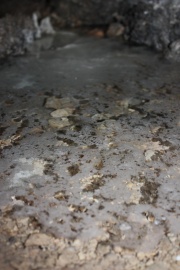
The Raft field of the Calcite section is used to record stations where calcite cave rafts are observed.
Cave rafts are thin accumulations of calcite or aragonite or more rarely gypsum that form on the surface of cave pools. Only calcite or aragonite cave rafts should be recorded in this field. Gypsum rafts have their own field.
Cave rafts form as extremely thin accumulations of crystals floating on the surface of a pool only because of surface tension. They form on still water. As they grow, they grow downward becoming thicker until they are too massive to float or are disturbed in which case they sink to the bottom of the pool. If sinking cave rafts accumulate in the same place (because of dripping water, for example), they may pile up into what is known as a raft cone.
Cave rafts may be observed: on the surface of pools; under water on the bottom of a pool; or lying along the bottom of a former pool. Cave rafts on the surface of a pool may be very thin looking like a film of powder or dust on the water. Cave rafts are usually white, yellowish or brown in color and look like ice or very thin lily pads. They may be touching the edge of a pool or floating freely but are incapable of supporting their own weight should the pool drop, unlike shelfstone. The top sides of cave rafts are flat and may be smooth or glossy. The bottom sides are rough. The shape may be very irregular and may even have holes in it like lace.
Rafts usually do not exceed 15 cm in diameter and 1 mm in thickness (about the thickness of a piece of paper). If the rafts are in a dried pool, they may have become cemented to the floor or could still be loose.
Look for cave rafts in every pool encountered no matter its size. Also look for them on the bottom of pools or former pools.
See also
References
- Palmer, Arthur N. (2007) Cave Geology CAVE BOOKS, Dayton, OH pp 278-279 ISBN-13: 978-0-939748-66-2, ISBN-10: 0-939748-66-5
- Hill, Carol; Paolo Forti (1997) Cave Minerals of the World (Second Edition ed.) National Speleological Society p 88 ISBN: 1-879961-07-5
Raft, Calcite
Raft Cone
The Raft Cone field of the Calcite section is used to record stations where raft cones are observed.
Raft cones are piles of rafts. Dripping water can cause rafts to sink in the same location. They can pile up in flaky mounds that look like stalagmites. They may be cemented together, especially if exposed because the pool has dropped or may still be a loose pile of rafts. There is no separate field for gypsum raft cones even though there is a separate field for gypsum rafts; so, any observation of a raft cone should be recorded here no matter its composition. Raft cones may exhibit a hole in the top like a volcano where water has dissolved or eroded into the cone. Exposed raft cones can be obscured by secondary formations.
Look for raft cones in pools and former pools and anywhere rafts are observed.
See also
References
- Palmer, Arthur N. (2007) Cave Geology CAVE BOOKS, Dayton, OH p 279 ISBN-13: 978-0-939748-66-2, ISBN-10: 0-939748-66-5
- Hill, Carol; Paolo Forti (1997) Cave Minerals of the World (Second Edition ed.) National Speleological Society pp 88-91 ISBN: 1-879961-07-5
Raft Cone, Calcite
Rim
The Rim field of the Calcite section should be used to record stations that exhibit rims of calcite. Other mineral rims have their own field in their respective sections.
Calcite rims (also sometimes known as vents) are wind formed features of calcite. They form usually around constrictions where consistent airflow is present. They are smooth on the inside but rough on the outside with features such as popcorn lining the outside surface. Rims form as a shell or projection extending on the upwind side of a constriction where moisture laden air consistently escapes. As such, they tend to require a pool or water source somewhere on the downwind side in order to provide the moist, warm air.
Rims can be any of a number of shapes from round tubes or eggs to more irregular shells or ears. They tend to conform somewhat to the shape of the constriction but may be biased in only one direction by the airflow. They can be found on the floor, walls or ceiling; anywhere air is or was escaping.
Rims can form from various mineral materials and several of them have fields on the inventory form. The appropriate field based on the mineral content of the rim feature should be used. Only calcite rims are recorded in this field.
See also
References
- Palmer, Arthur N. (2007) Cave Geology CAVE BOOKS, Dayton, OH pp 331-333 ISBN-13: 978-0-939748-66-2, ISBN-10: 0-939748-66-5
- Hill, Carol; Paolo Forti (1997) Cave Minerals of the World (Second Edition ed.) National Speleological Society pp 91-92 ISBN: 1-879961-07-5
Rimstone Dam
The Rimstone Dam field of the Calcite section should be used to record any observation of rimstone dams.
Rimstone dams are calcite deposits that form at the edges of water to make terraces or walls over which the water spills. Unlike shelfstone, they are not flat and horizontal, but are sloped and have height. Each terrace is stair-stepped from its neighbor. They form at the edges of pools or along sloping water paths when the water spills and loses some of its CO2.
Rimstone dams can occur singularly or in large, cascading terraces of dams. The spaces behind each dam will usually be lined with pool spar. They can vary greatly in both height and width from small ripples to large walls. Smaller rimstone dams are also known as gours.
Look for them on the floor where water may have once flowed and take care during survey not to damage them as the walls can be very thin and fragile.
See also
References
- Hill, Carol; Paolo Forti (1997) Cave Minerals of the World (Second Edition ed.) National Speleological Society pp 92-94 ISBN: 1-879961-07-5
- Palmer, Arthur N. (2007) Cave Geology CAVE BOOKS, Dayton, OH pp 277-278 ISBN-13: 978-0-939748-66-2, ISBN-10: 0-939748-66-5
Rimstone Dam, Calcite
Rimstone dam. Other items visible include: shelfstone, popcorn, and a crust over floor sediments. |
Shelfstone
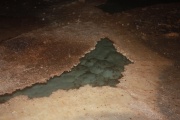
The Shelfstone field of the Calcite section should be used to record any observation of shelfstone.
Shelfstone is a flat ledge of calcite that grew at the edge of a pool. It extends inwardly creating a ledge above the water. They can also form around other speleothems such as columns and stalagmites to form tables and lily pads.
Shelfstone forms at the pool surface and if the pool level changes over time, multiple levels of shelfstone can form. Shelfstone can be left high and dry when a former pool has dropped or disappeared. Its presence indicates a former pool level or paleo-waterline. Shelfstone is usually only a few centimeters thick but its width can vary greatly even up to several meters. Chenille/Pool spar, pool fingers and subaqueous helictites can be found under shelfstone so be sure to examine it for these speleothem types. Shelfstone may not be thick enough nor strong enough to support weight without breaking so take great care when crossing shelfstone and keep your weight on the more substantial surfaces.
Look for shelfstone at the edges of any pool or former pool.
See also
References
- Hill, Carol; Paolo Forti (1997) Cave Minerals of the World (Second Edition ed.) National Speleological Society pp 97-98 ISBN: 1-879961-07-5
- Palmer, Arthur N. (2007) Cave Geology CAVE BOOKS, Dayton, OH p 278 ISBN-13: 978-0-939748-66-2, ISBN-10: 0-939748-66-5
Shelfstone, Calcite
Spar
The Spar subsection of the Calcite section records stations where some type of spar is observed.
Spar crystals are classified on the CCNP Cave Inventory Form as to their shape and location. Spar crystals that form in pools of water above the water table are known as pool spar. Those that form under the water table are classified as either dogtooth or nailhead according to the shape of the individual crystals.
All three of the spar types are calcite though other minerals can form spar.
References
- Hill, Carol; Paolo Forti (1997) Cave Minerals of the World (Second Edition ed.) National Speleological Society p 101 ISBN: 1-879961-07-5
Fields
Shield
The Shield field of the Calcite section should be used to record stations where a shield is found.
A shield appears as two parallel plates of calcite separated by a thin crack. The crack may not be visible at the edges because it is too thin or obscured. Shields are usually flat on top and usually oval in shape. They grow outward at their edges and can be attached to bedrock or other speleothems (usually columns). They are rarely parallel to the floor and most often have a noticeable slant. They are often decorated underneath with other formations such as stalactites. These could reach the floor forming a column between the shield and the floor. Shields may also be decorated on top by secondary speleothems such as stalagmites. True shields are rare and occasionally other features such as a flat rock or welts from a crack in a column are mistakenly identified as shields.
References
- Palmer, Arthur N. (2007) Cave Geology CAVE BOOKS, Dayton, OH pp 286-287 ISBN-13: 978-0-939748-66-2, ISBN-10: 0-939748-66-5
- Hill, Carol; Paolo Forti (1997) Cave Minerals of the World (Second Edition ed.) National Speleological Society p 98 ISBN: 1-879961-07-5
Shield, Calcite
Splash Ring
The Splash Ring field is used to record stations where cave rings appear.
Splash rings (also known as cave rings) are noticeable rings of calcite usually around a central splash point. There are two primary, identified mechanisms for splash ring development. There is no need to note the mechanism on the form; but, it can usually be identified by the diameter of the ring and the presence or absense of a central, hollow stalagmite.
The first and most common mechanism is when drips of water strike a soft floor surface such as sediment or guano. If there is sufficient height, the drips may form a depression and splash outward, depositing their minerals in a circle around the splash point. A central stalagmite may form at the same time. This type of splash ring is almost always between 0.8 and 2 meters in diameter.
The second mechanism is experimentally demonstrated to be when droplets fall and separate into smaller droplets on their way to the floor. This mechanism forms much smaller rings and may not have a central splash point; but, a small mound or stalagmite in the center.
Another, more rare type of splash ring has been observed in the Guads in gypsum. Splash rings can also form when splashes strike hard floor surfaces and wash off softer materials such as sediments or hydromagnesite.
Splash rings are very round when the floor is flat. If the floor has a slope, they will take on an eliptical shape. The ring could be partially obstructed and thus may not form a complete circle.
Look for splash rings on the floor especially when the floor material is soft.
See also
References
- Hill, Carol; Paolo Forti (1997) Cave Minerals of the World (Second Edition ed.) National Speleological Society pp 94-95 ISBN: 1-879961-07-5
Splash Ring, Calcite
Tray
The Tray field of the Calcite section should record stations which exhibit cave trays.
Trays hang down from the ceiling or on overhangs from the walls but end abruptly on the bottom creating a noticeably flat underside. They usually form under bedrock ceiling pendants but may form under stalactites. In the Guadalupe Mountains, they are usually calcite and heavily encrusted with popcorn and aragonite frostwork. Trays can form next to each other at different levels. Hollow stalagmites can sometimes be found directly below the trays and may exhibit as a splash ring.
See also
References
- Allison, Stan. Canyons & Caves; Issue No. 19; Winter 2000 - 2001; CAVE TRAYS: http://www.nps.gov/cave/planyourvisit/upload/c&c19.pdf
- Palmer, Arthur N. (2007) Cave Geology CAVE BOOKS, Dayton, OH p288 ISBN-13: 978-0-939748-66-2, ISBN-10: 0-939748-66-5
Tray, Calcite
Trays with nailhead spar |

